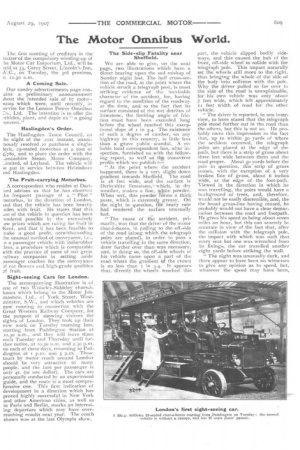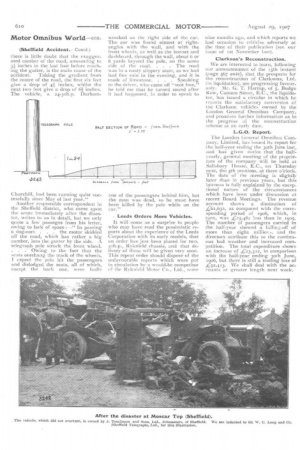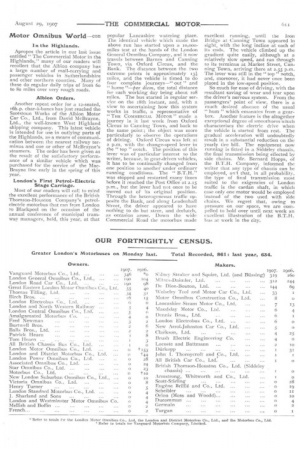The Motor Omnibus World.
Page 7

Page 8

Page 9

If you've noticed an error in this article please click here to report it so we can fix it.
The first meeting of creditors in the natter of the compulsory winding-up of he Motor Car Emporium, Ltd., will be ield at 33, Carey Street, Lincoln's Inn, X.C., on Tuesday, the 3rd proximo, it 11.30 a.m.
A Coming Sale.
Our sundry advertisements page conains a preliminary announcement ibout the intended sale of 67 motorruses which were, until recently, in ;ervice for the London Power Omnibus -2o., Ltd. The intention is to offer the 7ehicles-, plant, and depot as " a going ortcern," Haslingden's Order.
The Haslingden Town Council, on he night of the 21st instant, unaniuously resolved to purchase a singleleek, 25-seated motorbus at a cost of 478o, and to place the order with the -ancashire Steam Motor Company, .-imited, of Leyland. The vehicle will ie put in service between Helmshore md Haslingden.
The Fruit-carrying Motorbus.
A correspondent who resides at Dart'ord advises us that he has observed he frequent passage of a ' Pilot " notorbus, in the direction of London, Ind that the vehicle has been heavily scion with fruit. He states that this ase of the vehicle in question has been 7endered possible by the excessively .ow prices which are ruling for fruit in Kent, and that it has been feasible to make a good profit, notwithstanding :he unusual method of conveyance, i.e., _a a passenger vehicle with indiarubber :ires, a procedure which is comparable with the practice of some of our great railway oompanies in setting aside passenger coaches for the conveyance af cut flowers and high-grade qualities af fruit.
Sight-seeing Cars for London.
The accompanying illustration is of one of two Wolseley-Siddeley chars-hbanes which belong to the Motor Jobmasters, Ltd., of York Street, Westminster, S.W., and which vehicles are now running in connection with the Great Western Railway Conipany, for the purpose of showing visitors the sights of London. They took up their new work on Tuesday morning last, starting from Paddington Station at 10.30 a.m., and thev will leave there each Tuesday and Thursday until further notice, at 10.30 :4-M. and 2.3o p.m. on each of these days, returning to Paddington at i p.m. and 5 p.m. These tours by motor coach around London should be very attractive to many people, and the fare per passenger is only 48. (or one dollar). The cars arc personally conducted by an experienced guide, and the route is a most comprehensive one. This first indication of development in a direction which has proved highly successful in New York and other American cities, as well as in Paris and Berlin, marks an interesting departhre which may have Overreaching results next year. The coach shown was at the last Olympia show. The Side-slip Fatality near Sheffield.
We are able to give, on the next page, two illustrations which have a direct bearing upon the sad mishap of Sunday night last. The half cross-section of the road, at the point where the vehicle struck a telegraph post, is most striking evidence of the inevitable character of the accident, for, having regard to the condition of the roadway at the time, and to the fact that its surface consisted of the wet detritus of limestone, the limiting angle of friction must have been exceeded long before the wheel reached this exceptional slope of i in 3.4 The existence of such a degree of camber, on any highway in this country, is little less than a grave public scandal. A reliable local correspondent has, after inspection, furnished us with the following report, as lvell as tl$. transverse profile which we publish
"At the point where the accident happened, there is a very slight down gradient _towards Sheffield, The road is 18 feet wide, and the surface is Derbyshire limestone,which, in dry weather, makes a fine, white powder. When wet, this powder lams a thick paste, which is extremely greasy. On the night in. question, the heavy rain had rendered the surface unusually bad.
"-The .cause of the accident, primarily, was that the driver of the motor char-a-banes, in pulling to the off-side of the road (along which the telegraph poles are placed), in order to pass a vehicle travelling in the same direction, drew further over than was necessary, and, in doing so, the off-side wheels of his vehicle came upon a part of the road where the gradient Of the crown is no less than t in 3.4. It appears that, directly the wheels touched this part, the vehicle slipped bodily. sideways, and this caused the hub of the front, off-side wheel to collide with the telegraph pole. This impact naturally set the wheels still more to the right, thus bringing the whole of the side of the body into collision With the pole. Why the driver pulled so far over to the side of the road is unexplainable, for his own vehicle was only about 7 feet wide, which left approximately it feet width of road for the other vehicle.
" The driver is reported, in one interview, to have stated that the telegraph pole stood further out in the road than the others, but this is not so. He probably owes this impression to the fact that, up to within so yards of where the accident occurred, the telegraph poles are placed at the edge of the path, but there is a strip of grass about three feet wide between them and the road proper. About so yards before the pole in question, this strip of grass ceases, with the exception of a very broken line of grass, about 6 inches wide, at the edge of the foot-path. Viewed in the direction in which he was travelling, the poles would have a hnckground of trees, and, therefore, wculd not be easily discernible, and, the the broad grass-line having ceased, he probably would not have a clear demarcation between the road and footpath. He gives his speed as being about seven miles an hour, but this can scarcely be accurate in view of the fact that, after the -collision with the .telegraph pole, the impact with which was such that every seat but one was wrenched from its fixings, the car travelled another eight yards before striking the wall.
" The night was unusually dark, and there appear to have been no witnesses to give any opinion as to speed, but, whatever the speed may have been,
(Sheffield Aecident.--Coutd.)
there is little doubt that the exaggerated camber of the road, amounting to 31 inches in the last foot before reaching the gutter, is the main cause of the accident. Taking the gradient from the centre of the road, the first six feet give a drop of 44 inches, whilst the next two feet give a drop of 64 inches. The vehicle, a 24-3oh.p. Durham Churchill, had been running quite successfully since May of last year,"
Another responsible correspondent in the Sheffield district, who came upon the scene immediately after the disaster, writes to us in detail, but we only quote a few passages from his letter, owing to lack of spaoe ;--" In passing a dog-cart . . . the motor skidded off the road, which has rather a big camber, into the gutter by the side. A telegraph pole struck the front wheel.
• . . Owing to the fact that the seats overhang the track of the wheels, I -expect the pole hit the passengers and dislodged the seats, all of which, except the back one, were badly
wrecked on the right side of the car. The car was found almost at rightangles with the wall, and with the front wheels, as well as the bonnet and dashboard, through the wall, about 6 or 8 yards beyond the pole, on the same side of the toad. . . . The road -was in a nasty slippery state, as we had had fine rain in the evening, and it is made (:).f. limestone Speaking to the driver, who came off "scot free," he told me that he turned round after it had happened, in order to speak to
one of the passengers behind him, but the man was dead, so he must have been killed by the pole while on the car."
. Leeds Orders More Vehicles.
It will come as a surprise to people who may have read the pessimistic reports about the experience of the Leeds Corporation with its early models, that an order has just been placed for two, 4oh.p., Ryknield chassis, and that delivery of these will be given very so-on. This repeat order should dispose of the unfavourable reports which were put in circulation by a would-be competitor of the Rvknield Motor Co., Ltd., 5011Te
nine months ago, and which reports we Lad occasion to criticise adversely at the time of their publication (see our issue of ist November last).
Clarkson's Reconstruction.
We are interested to learn, following our announcement of the isth instant (page 567 ante), that the prospects for the reconstruction of Clarksons, Ltd. (in liquidation), are progressing favourably. Mr. G. T. Harrap, of5, Budge Row, Cannon Street, E.C., the liquidator, has issued a circular in which he reports the satisfactory conversion of the Clarkson vehicles owned by the London General Omnibus Company, and promises further information as to the progress of the reconstruction scheme at an early date.
L.G.O. Report.
Tbe London General Omnibus Company, Limited, has issued its report for the 'half-year ending the 3oth June last, and has given notice that the halfyearly, general meeting of the proprietors of the company will be held at Salisbury house, E.C., on Thursday next, the 5th proximo, at three o'clock. The date of the meeting is slightly later than in previous years, but this lateness is fully explained by the exceptional nature of the circumstances which have been under discussion at recent Board Meetings. The revenue account shows a diminution of ,61,632, as compared with the corresponding period of 1906, which, in turn, was £25,482 less than in 1905. The number of passengers carried in the half-year showed a falling-off of
more than eight and the directors attribute this to the continuous bad weather and increased corn-petition. The total expenditure shows an increase of 1;23,312, in comparison with the half-year ending 3oth June, 1906, but there is still a trading loss of -i:52,413. We shall deal with the aceounts at greater length next week. In the Highlands.
Apropos the article in our last issue entitled" The Commercial Motor in the Highlands," many of our readers will recollect that the Albion company has a large number of mail-carrying and passenger vehicles in Sutherlandshire and other northern counties. Many of these do regular daily trips of from 6o to 8o miles over very rough roads.
Albion Orders.
Another repeat order for a 12-seated, x6h.p. char-a-bancs has just reached the Scotstoun Works of the Albion Motor Car Co., Ltd., from David McBrayne, Ltd., the well-known West Highland shipping company. This latest vehicle is intended for use in outlying parts of the Highlands, as.a means of communication between the nearest railway terminus and one or other of McBrayne's steamers. The order has been given as the result of the satisfactory performance of a similar vehicle which was purchased for the service of the MacBrayne line early in the spring of this year.
London's First Petrol-Electric Stage Carriage.
Most of our readers will call to mind the excellent performance of the British Thomson-Houston Company's petrolelectric motorbus that ran from London to Blackpool on the occasion of the annual conference of municipal tramway managers, held, this year, at that popular Lancashire watering place. The identical vehicle which made the above run has started upon a to,000miles test at the hands of the London General Omnibus Company, and it now travels between Barnes and Canning Town, via Oxford Circus, and the Bank. The distance between the two extreme points is approximately 13,1 miles, and the vehicle is timed to do four complete journeys—" out" and " home "—per diem, the total distance for each working day being about to8 miles. The bus started in regular service on the x8th instant, and, with a view to ascertaining how this system works in traffic, a representative of "THE COMMERCIAL MOTOR" made a journey in it last week from Oxford Circus to Canning Town, and back to the same point ; the object was more particularly to observe the operations of driving. Oxford Circus was left at 2 p.m. with the change-speed lever in the "top " notch. The position of this lever was of particular interest to the writer, because, in gear-driven vehicles, it has to be continually changed from one position to another under ordinary running conditions. The " B.T.H." was stopped and restarted many times before it reached the Post Office at 2.15 p.m., but the lever had not once to be moved out of its original position. Through the heterogeneous traffic opposite the Bank, and along Leadenhall Street, the driver appeared to have nothing to do but steer, and declutch, as occasion arose. Down the wide Commercial Road the motorbus made excellent running, until the Iron Bridge at Canning Town appeared in sight, with the long incline at each of its ends. The vehicle climbed up the gradient quite easily, although at a relatively slow speed, and ran through to its terminus at Market Street, Canning Town, arriving there at 2.55 p.m. The lever was still in the "top " notch, and, moreover, it had never once been placed in the low-speed position.
So much for ease of driving, with the resultant saving of wear and tear upon the driver's nervous system. From the passengers' point of view, there is a much desired absence of the usual " hum " which emanates from a gearbox. Another feature is the altogether exceptional degree of smoothness which characterisesthe electric drive when the vehicle is started from rest. The gradual acceleration will undoubtedly result in a substantial reduction on the yearly tire bill. The equipment now running is fitted in a Siddeley chassis, the final transmission being effected by side chains. Mr. Bernard Hopps, of the B.T.H. Company, informed the writer that any type of chassis can be employed, an-I that, in all probability, the type of final transmission most suited to the exigencies of London traffic is the cardan shaft, in which case only one motor would be employed instead of the two used with side chains. We regret that, owing to pressure on our space, we are compelled to hold over until next week an excellent illustration of the B.T.H. bus at work in the city.






















